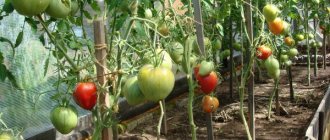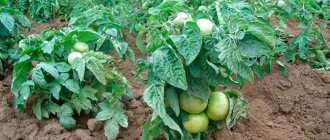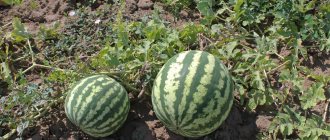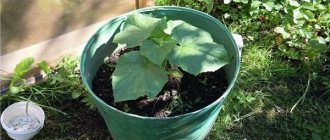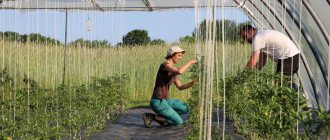Features of growing watermelons in the Moscow region
To grow watermelons in conditions of not very hot and rather short summers, you will have to comply with a number of conditions:
- plant only early and early ripening varieties;
- grow by seedling method;
- plant seedlings in high beds under temporary shelter, in a greenhouse or greenhouse;
- generously fill the beds (preferably in the fall) with rotted organic matter;
- maintain a temperature of at least +12 °C for young plants.
Varieties and hybrids of watermelons for the Moscow region
In the Moscow region you can grow large watermelons weighing 6 kg or more. The varieties discussed in the article received excellent reviews from summer residents.
- Ogonyok is an old, proven variety of Kharkov selection. Round fruits weighing up to 2.5 kg with dark green skin ripen annually in open ground. The fire is resistant to fusarium, but can be affected by powdery mildew. The bark is thin and fragile. The taste is good. The seeds are small and dark. Exactly three months pass from sowing to harvesting ripe watermelons.
- Sugar baby - the name translates as “sugar baby”. Berries weighing 1 kilogram. The bark is thin, dark green with stripes. The pulp is dark red. The taste is excellent. The seeds are brown with spots and small.
- Vector is a new ultra-early ripening variety. The first fruits can be tasted on the 58th day after sowing. The weight of each watermelon is about 3 kg, some specimens reach up to 5 kg. The crust is thin. The taste is excellent. This variety, bred in Russia, was included in the State Register of Breeding Achievements in 2022. The Vector variety is considered the most delicious among early ripening varieties and hybrids. Can be stored for up to 20 days.
- Photon is an early-ripening large-fruited variety, fruit weight up to 6 kg. Familiar striped coloring, original oval shape, good taste. The thickness of the bark is 1.4 cm. In central Russia it is grown by seedlings. Resistant to diseases.
- Gift to the North F1 is the largest-fruited early ripening variety. Berries weight up to 10 kg. The rind is very thick, like all large-fruited watermelons. Ripens 80 days after germination. Weight in the Moscow region is about 5 kilograms. The hybrid is cold-resistant, the fruits ripen even in cool weather. In the conditions of central Russia, when sown for seedlings at the end of April or beginning of May, watermelons will ripen in the second half of August.
- Charleston F1 near Moscow is a sweet, large-fruited hybrid of early ripening (75–85 days). Can grow both in a greenhouse and in open ground. Fruit weight is from 2.5 to 7 kg. In a greenhouse, when grown on a trellis, the fruits are smaller, 2–3 kg.
- Pink champagne F1 - reviews from summer residents from the Moscow region about this variety are positive. Early ripening. More demanding of heat than Podarok Severu F1 and Podmoskovny Charleston F1. The bark is thick, the flesh is light pink, sweet. In the conditions of the Moscow region, only one fruit sets on a plant, the weight of which in high beds filled with organic matter reaches 7 kg.
Photo gallery: suitable varieties and hybrids of watermelons for the Moscow region
Protection from diseases and pests
Of course, diseases of melon crops are best prevented, since treatment is not always effective and often causes the death of the plant. Watermelon plantings are especially often affected by the following diseases:
- fungal infection by powdery mildew is accompanied by the appearance of a grayish-white coating, causing the death of foliage, deformation and rotting of fruits;
- damage by downy mildew is most often observed on old leaves in the form of the formation of angular light yellow spots and is accompanied by a cessation of plant development;
- a common disease, olive spot, involves the appearance of irregularly shaped spots, corrugated leaves and falling ovaries;
- when affected by bacteriosis, characteristic whitish oily spots form on watermelon leaves, resulting in the withering of the stems and fruits;
- fungal infection of anthracnose is accompanied by the appearance of brown or yellow spots, which in conditions of high humidity become covered with a pinkish coating;
- rot of the aerial parts and root system have a destructive effect and often cause complete death of the plant;
- It is very dangerous for watermelons to be infected with cucumber mosaic, since such a viral disease is almost impossible to cure.
Watermelon beds
A successful choice of landing site is half the success. Watermelon loves space and does not tolerate shade. It is necessary that the bushes are illuminated by the sun all day, right down to the last leaf. A small slope will do. The rows in this case are placed in a horizontal plane, and not from top to bottom.
The beds for planting watermelons are prepared in the fall. The roots of the watermelon go 40 cm deep. If the loose, fertile layer is smaller, the bushes will not be able to develop normally. Therefore, on heavy clay soils, planting holes are made 45–50 cm deep. Even before planting the seedlings, well-decomposed humus mixed with sand is added to the holes: one or two shovels of humus and up to three liters of sand per plant. The quantity is determined based on the condition of the original soil - whether it is light or heavy.
In regions with cool climates, watermelons are grown in high, warm beds. The ideal option is to place biofuel in a narrow trench and make rows of holes along the trench on both sides. The distance between rows is 80 cm. In a row between plants is 1 m. Between the edges of the beds is at least three meters.
Advice from experienced farmers
For those who are just starting to grow watermelons, the following advice from experienced farmers will help:
- in short and cool summer conditions, it is preferable to grow melons, including watermelons, in warm beds - then the plants will be healthier and the fruits will ripen earlier;
- the formation of watermelon bushes speeds up the harvest - if the side vines are not pinched, the fruits will be small and will not have time to ripen;
- when planting seedlings, it is important to maintain the recommended distance between plants - thickening of plantings inhibits the growth of the bush and contributes to the development of diseases;
- After the fruits have formed, it is good to place boards or other suitable material under them - this way you will prevent spoilage and rotting of the watermelons.
Growing seedlings
All summer residents purchase seeds in a huge supply, three times more than necessary. Firstly, I want to try different varieties and hybrids, and secondly, there is no guarantee that the seeds will sprout. However, you will have to sow a very specific amount, 4–6 more than the holes prepared for seedlings. In warm conditions, the seeds germinate within a week from the start of germination or earlier, and it is already clear how many seeds to soak for the second sowing.
When to sow watermelons
Instructions on the bags and experienced gardeners say that the seedlings should be 25–30 days old at the time of planting. If they are planted in a greenhouse or greenhouse using biofuel, this period can be maintained. But for planting in a bed under film, it is better to sow three weeks before the intended planting. If it is warm and sunny, three-week-old seedlings will take root faster than month-old ones. In case of bad weather, the landing should be postponed for a week.
A month after sowing, watermelon seedlings are ready for transplanting
How to help seeds germinate
The seeds can be processed by the manufacturer, then they are sold in the form of granules, which do not need to be soaked, since the shell of the granules contains nutrients and protective substances. Seeds not in granules are soaked to speed up germination.
- The seeds are soaked without treatment for a few seconds and then washed. After this, the seeds of each variety are placed in bags made of thin fabric and immersed in hot water (50–60 °C) for half an hour, then in cold water, but without chlorine. The ties on the bags are made in different colors and the variety is written down.
- Fitosporin-M is diluted in a jar (15 drops per glass of water). The seeds are kept in this solution for 8–10 hours, then together with the bags they are placed in a plastic bag and placed in the refrigerator for 12 hours.
Soaking in a solution of Fitosporin-M is used to protect future plants from fungal and bacterial diseases - After cooling, the bags of seeds are wrapped in a clean cloth and then placed in a plastic bag in a warm place until germination (for about two days). Be sure to unwrap and ventilate every day, morning and evening.
Seeds need 24–28 °C to germinate. Usually the top shelf of a kitchen cabinet is the best place, but it's best to check with a thermometer.
The seeds are sown three days after soaking. You can’t put it off any longer, because it’s easy to damage the roots of sprouted seeds.
Sowing watermelon seeds in cups
Cups for watermelons are 0.5 liters in volume, preferably plastic rather than paper.
- A small cut is made in the upper part of the disposable “pot” to make it easier to remove the plants later. Drainage is not needed, but the holes in the bottom of the pot should be 1 cm in diameter, and not one, but three or four.
- Light soil is required: a mixture of leaf humus, compost and vermiculite (5:5:1). If there is no leaf humus, take peat or rotted sawdust.
- Watermelons stretch out in artificial light. Therefore, the cups are filled with soil up to half the height. Then lightly compact the soil, water and spread the seeds, sprinkle a 2 cm layer on top and carefully compact again. And then add washed, well-dried and heated sand a little, in a layer of only 2-3 ml.
- Until the shoots appear, keep the cups in a warm place and do not water them.
If there is not enough space on the windowsills, you can sow the soaked seeds in a common container and then plant them.
Video: how to plant watermelon seeds correctly
Seedling care
As soon as the first shoots appear, it is necessary to provide illumination for 12 hours a day. 10 days after sowing, the temperature at night is reduced to 18–20 °C to prevent sprouts from stretching.
The first feeding is done after the appearance of the second true leaf (the first leaves that appear above the ground are called cotyledons; then true leaves grow).
The first, oval leaves of a watermelon are cotyledons, and those with cuttings are true
Liquid organomineral fertilizers intended for seedlings or indoor flowers are suitable. Fertilizer is applied at the root; it should not fall on the leaves. Two tablespoons of nutrient solution is enough per plant. After fertilizing, you should immediately water it with clean water.
A day after feeding, the seedlings are placed on the windowsill. It is important that small plants do not end up in a draft or fall under a stream of cold air from a window.
The second feeding is done 10–12 days after the first. A daily infusion of wood ash is taken for it. Per liter of boiling water - 2 level tablespoons. Stir and cover with a lid. After a day, carefully drain the sediment and filter.
Harvesting
The harvest is harvested in several stages as the fruits ripen. Watermelons, unlike melons, do not ripen well during storage, so they are harvested when the flesh has already turned pink and the seeds have acquired a characteristic color.
Fully ripened watermelons also do not have good shelf life. A month after being removed from the garden, the pulp of the fruit softens.
The ripeness of a watermelon is determined by external signs. In a mature fruit, the stalk and tendrils near it dry out. The bark becomes shiny, elastic, and the color becomes intense. A large yellow spot forms on the crust on the ground side. When tapped, the ripe fruit produces a dull sound.
Ripe watermelons are cut from the stem with a knife, leaving a tail about 5 cm long. If the tail is broken off, the fruit quickly rots.
Watermelons are delivered to the storage location in containers or on pallets. They are lined with straw or shavings. The same materials are used to lay the rows of watermelons themselves. You can transport watermelons without any container, laying them out in one row on a straw bed.
Planting watermelon seedlings in a greenhouse
Watermelons can be planted in a greenhouse from the moment the soil warms up to 15 °C (check with a regular outdoor thermometer - place it on the surface of the ground). The beds covered with black film or black spunbond will warm up faster.
Since the vines of watermelons are long, the plants are tied to a trellis or net, like cucumbers. The trellis is installed before planting the seedlings. The vines are guided along twine stretched from bottom to top between the trellis wires. You need to help the plants a little by slightly twisting the main lash around the rope. The berries themselves are hung in nets as soon as the ovaries become the size of a large apple. The nets are attached to the trellis or frame of the greenhouse. It is necessary to take into account what the watermelon will be like so that the mesh does not turn out to be tight and does not break.
Watermelon fruits have to be hung in nets so that they do not break the stem due to their weight
Some gardeners use hemp instead of mesh, made from scrap materials, for example, from plastic bottles.
An original solution to place watermelons on stumps will protect the fruits from being torn from the bush
The distance between rows in the greenhouse is 1 m, in a row - 50–70 cm, depending on the variety. For large-fruited hybrids grown in one stem, a 70x70 cm scheme is suitable. Plant at the same depth as in the pot. The wells are watered with heated water (room temperature).
Seedlings must be covered. Mini-greenhouses are made from five-liter bottles with the bottom cut off for each bush, the lids are removed. In order not to cover each bush separately, you can install arcs 45–50 cm high and stretch the spunbond. With a density of 25-30 g/m2, two layers are made, 42-60 g/m2 - one. Film cannot be used to cover watermelon plants in a greenhouse; seedlings may die under it.
Video: planting grown watermelon seedlings in a greenhouse
Creeper formation
In a greenhouse, excess leaves create excess humidity and reduce lighting for plants. On the lash with the resulting watermelon, only the 5 following leaves are left. Not all ovaries are left, because the more fruits grow on the bush, the longer the ripening takes. The maximum possible load on a plant in a greenhouse is 10 kg. If a plant grows two watermelons weighing 8 kg each, they will not even have time to turn red before the cold weather begins and they will not gain any sweetness. On one side shoot you can leave no more than two fruits with a distance between watermelons on a lash of 5-6 leaves. If it is known that the fruits will weigh 3–3.5 kg, only 3 ovaries are left. On large-fruited varieties and hybrids (with fruits weighing more than 8 kg), two ovaries are left, but when the watermelons become larger than a walnut, the excess one is cut off.
In order for the watermelons to ripen, remove excess shoots and leaves.
In hybrids, the fruits are set on the main vine. Stepchildren are removed. The top is pinched at a height of 1.8 m. In varietal watermelons, female flowers are formed mainly on the side shoots. Therefore, above the 7th–9th leaf, you need to pinch off the top so that the watermelon begins to branch. The lowest 1–2 sprouts are removed from the leaf axils. When the fruits set, cut out all excess shoots, and pinch off the fruiting ones 5 leaves after the ovary.
Pollination
Bees may not be able to pollinate greenhouse watermelons. If the hive is not located in the greenhouse itself or nearby, you will have to pollinate it manually. This is not difficult, but the flowers do not bloom in one day, and you will have to replace the bee in several steps.
The female flowers already have tiny watermelons on them when they open. You need to carefully pick or cut off the male flower, bend back the petals and lightly touch the stamens of the female flower with the pestle. It is important that both flowers just open and do not fade.
Pollination is completed when it becomes clear that each plant has the required number of ovaries.
The female flower grows at the same time as the watermelon
Features of growing watermelons in open ground
Hybrid varieties of watermelons are well suited for open ground, as they are more resistant to diseases and sudden temperature changes (Moscow Charleston F1, Gift to the North F1). As for the timing of ripening, it makes sense to plant only early ripening varieties in open ground in the Moscow region. Then, even in not too warm summer conditions, watermelons will have time to grow and acquire the sugar content required for the variety. Seedlings are planted at the end of May at the age of 33–35 days. Seedlings should have four true leaves.
- About a week before planting seedlings in the garden, they are hardened on a balcony, loggia or in a greenhouse. At the same time, the number of waterings is reduced. However, on the eve of transplantation, the seedlings are well watered and sprayed with a 1% solution of Bordeaux mixture to prevent fungal diseases.
- The seedlings are planted in warm beds prepared in the fall. After planting, water once a week, and if the weather is very hot, then 2 times a week. After the appearance of female flowers, watering is carried out less frequently, and when the fruits are formed, it is stopped.
- Watermelons in open ground in the Moscow region must be covered. After planting, they are grown under film or spunbond until the end of June. In July, the shelter is left only at night if the nights are cold. At the same time, do not forget about ventilation so that condensation does not accumulate under the film or spunbond, since excessive humidity can lead to rotting of the watermelon fruits.
- Pollination of watermelons growing in open ground usually takes place without human intervention, with the help of insects. In order for bees and other pollinators to fly into the garden, plants with a scent that attracts bees, for example, alyssum, are planted next to the garden bed.
Video: growing watermelons in open ground
Favorable conditions for growth
Watermelons are heat-loving plants with a massive above-ground part. They love spacious sunny areas and cannot tolerate even slight shade. Therefore, it is better to prepare large beds for them, without saving space, away from trees and shrubs. Successful cultivation of juicy watermelons and melons in the open ground of the Moscow region is quite possible, although it requires some knowledge and certain skills.
Harvest
Having created optimal conditions for heat-loving melons on your own plot, by the end of summer you can pleasantly surprise your family and friends with your own watermelons and melons. The soil for melons should be light and well fertilized so that the plant receives enough nutrients for active growth and rapid ripening of fruits. In early and mid-summer, plants require abundant watering, so if natural precipitation is insufficient, you will have to take care of additional irrigation. You need to try to ensure that warm water gets only onto the ground and not onto the foliage.
Important! In the second half of summer, when watermelons ripen, watering should be limited so that the crop gains the desired sweetness.
For the construction of a melon bed, a gentle slope, well illuminated by the sun and devoid of tall vegetation, is ideal. Watermelon seedlings should be planted on it in vertical rows, then the overgrown vines will be well and evenly warmed by the sun's rays. Probably, the fruits may grow a little smaller in size than those of their southern neighbors, but they will not be inferior to them in terms of juiciness and sugar content.
Bed for melons
How to feed watermelons
Two weeks after planting, liquid fertilizing with organic matter is needed (chicken manure diluted in a ratio of 1:10 or green fertilizer - an infusion of grass fermented in the sun in a barrel of water for 3-5 days). After another two weeks - complex fertilizer with microelements. Only 0.5 liters of solution is poured onto the plant. The third feeding is done after fruit set with a daily infusion of ash (3 tablespoons of ash per liter of water), also 0.5 liters per plant. The soil must be mulched with sawdust or covering material with a high (up to 60 g/m2) density.
If you follow all the recommendations and in a good hot summer in the Moscow region, you can grow real sweet watermelons. Good luck to you, readers, and a good harvest!
Growing watermelons in the Moscow region: step-by-step instructions for greenhouses and open ground from yagodka.club.


